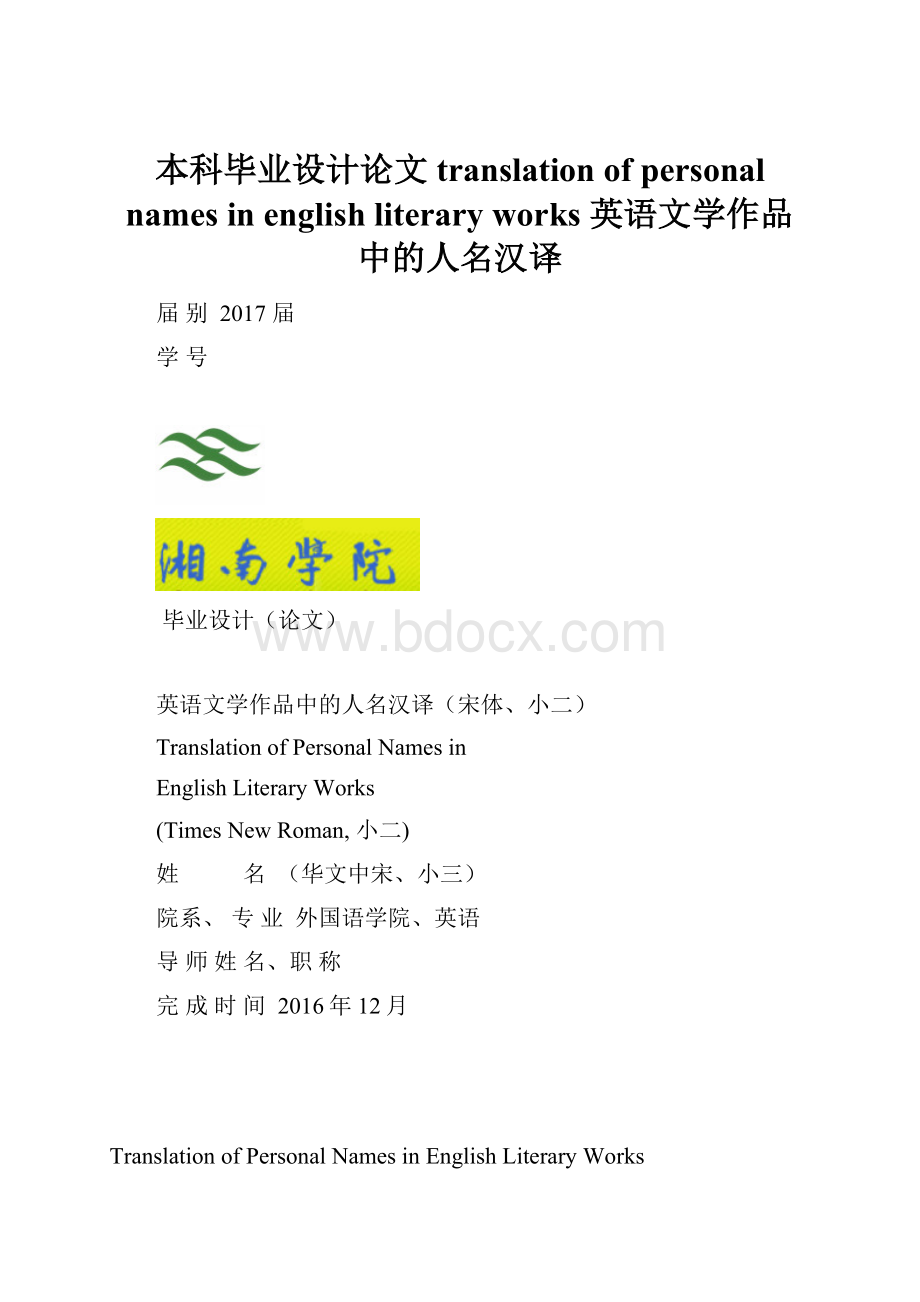本科毕业设计论文translation of personal names in english literary works英语文学作品中的人名汉译.docx
《本科毕业设计论文translation of personal names in english literary works英语文学作品中的人名汉译.docx》由会员分享,可在线阅读,更多相关《本科毕业设计论文translation of personal names in english literary works英语文学作品中的人名汉译.docx(17页珍藏版)》请在冰豆网上搜索。

本科毕业设计论文translationofpersonalnamesinenglishliteraryworks英语文学作品中的人名汉译
届别2017届
学号
毕业设计(论文)
英语文学作品中的人名汉译(宋体、小二)
TranslationofPersonalNamesin
EnglishLiteraryWorks
(TimesNewRoman,小二)
姓 名(华文中宋、小三)
院系、专业外国语学院、英语
导师姓名、职称
完成时间2016年12月
TranslationofPersonalNamesinEnglishLiteraryWorks
(英文标题:
TimesNewRoman,小三,加粗)
AThesis
SubmittedinPartialFulfillmentoftheRequirements
FortheBachelor’sDegreeinEnglishLanguageandLiterature
By
(汉语拼音)
UndergraduateProgram
DepartmentofForeignLanguages
XiangnanUniversity
Supervisor:
AcademicTitle:
Signature_______
Approved
December2016
CONTENTS
(TimesNewRoman大写、小三,居中、加粗、空一行)
(目录内容:
TimesNewRoman,五号字,其中一级标题还要加粗,分散对齐,行间距20磅,标题除每一行的首字母和专有名词大写外,单词首字母不要大写;各级标题的排序用阿拉伯数字表示,不能用ChapterOne或PartOne之类的标识,引言、结论、参考文献和致谢部分不要排序;各级标题各自对齐,二级标题比一级标题缩进3个字符后,再对齐,以此类推;中文摘要和英文摘要的页码标序分别用小写的i,ii表示。
)
AbstractinChinese……….…………………………………………………………………………………i
AbstractinEnglish…………………………………………………….……………………………………ii
Introduction………………………...……………………………………...………….……..………………1
1.Thedefinitionandcharacteristicsofpersonalname.........................................................................2
1.1Thedefinitionofpersonalname…..………………..............….........................................................2
1.2Thecharacteristicsofpersonalname……..…………………..............………................................2
1.2.1Symbolicness...............................................................................................................................2
1.2.2Definiteness.................................................................................................................................3
1.2.3Variation......................................................................................................................................3
2.Personalnameandculture....................................................................................................................5
2.1Relationshipbetweenpersonalnamesandculture.............................................................................5
2.2Culturalinformationinliteraryworks................................................................................................5
2.3Personalnamesinliteraryworks.................................................................................................6
3.NamingmethodsofpersonsinEnglishliterature…………………...….………………………….7
3.1Implyingthemeaninginpronunciation………………………...………….………….......................7
3.2Expressingthemeaningbypersonalnames…………………………..…................……………...7
3.3Originatingfromtheallusions………………………………………..…....................……………7
4.Translationstrategies..……………………………………………......…...…….………………....…9
4.1Twofundamentalstrategies:
domesticationandforeignization…..………..…..………….........…..9
4.2Translationstrategiesforpersonalnamesinliteraryworks……....….……………………….......9
4.2.1Foreignization………………..…………......….………………………….................................9
4.2.1.1Transliteration………………………………...….……………….................................9
4.2.2Domestication……..………..……….…....….…..….………..……….......…………………..10
4.2.2.1Culturecompensation……………………………..……..…….......…………………..10
4.2.2.2Givingupthename,onlygettingthemeaning..……………..….......………………..11
Conclusion………………………………………………………………………..……………………...12
Bibliography……………………………………………………………………….........………………….13
Acknowledgments..........................................................................................................………………….14
摘要
(小三,宋体、居中、空一行)
(正文:
宋体、小四、行间距20磅)
人名是一门艺术,也是人类社会中最普遍的语言现象,是人们利用语言符号区别他人的特定标志。
人名同复杂的社会文化有着深刻的联系,因而有着深刻的文化内涵。
本文选取了文学作品中的人名作为研究对象。
文学作品中的人名,往往是作者根据其创作意图,为更深刻地揭示人物性格,预示人物命运,体现作品的背景和主题而精心设计的,具有深远的延伸寓意。
然而某些寓意深刻的人名增添了文学作品的复杂性,从而使译者在翻译时难以把握。
为了最大限度地传达原作的寓意,保持原作的风格,译者在翻译文学作品中的人名时,应从文化的角度入手,采取归化和异化的基本翻译策略,以音译、文化补偿和取意舍名等方式灵活处理。
关键词:
人名翻译;文学作品;文化内涵;翻译策略
(关键词之间用分号隔开)
ABSTRACT
(TimesNewRoman、大写、小三、加粗、居中、空一行)
(正文:
小四、TimesNewRoman、行间距20磅)
Namingisanart.Names,whichareusedbyhumanbeings,arethecommonestlanguagephenomenoninhumansociety.Theyarethesignsforpeopletodistinguishonepersonfromanother.Namingisaspecialandlinguisticphenomenonwhichrelatestoculturesextensivelyandprofoundly.Thepresentpaperwillfocusonthestudyofpersonalnamesinliteraryworks.Someofthesenamesgivevividimagesofthecharacters,someofthemshowthetemperamentsofthecharacters,andsomeofthemsuggestthefateofthecharacters.Suchpersonalnamesinliteraryworksaremuchmoreintentionallygiventhanindailylife.Theytakethetasktohelpwiththedevelopmentofthewholework,sothetranslationofthemshouldalsobetakenintocarefulconsideration.Forthepurposeofbeingfaithfultothemeaningandstyleofthesourcetext,whentranslatingthepersonalnamesinliteraryworks,atranslatorshouldstartfromtheperspectiveofculture,flexiblytakingthetwobasictranslatingstrategies:
domesticationandforeignization.
Keywords:
translationofpersonalname;literaryworks;culturalconnotation;translationstrategies.
(关键词除了专有名词之外,单词首字母不要大写;关键词之间用分号隔开)
特别说明:
一、封面和封二之间插入“分页符”;
二、封二和目录之间插入“分节符”(方法:
点击“插入—分隔符—分节符类型中的“下一页”—“确定”);
三、目录和中英文摘要之间插入“分节符”,中英文摘要之间则插入“分页符”,中英文摘要的页码分别用“i、ii”标记;
四、中英文摘要和正文之间插入“分节符”;
五、正文各节之间插入“分页符”
六、页眉部分为“外国语学院英语专业2017届毕业论文”(楷体、小三号字,但页眉部分的文字内容只出现在论文正文部分,其它部分(不含封面和封二)页眉只留一条下划线,没有文字内容。
)
Introduction(TimesNewRoman、顶左对齐、小三、加粗、不空行)
(正文内容:
小四、TimesNewRoman、每段的首行向右缩进3个英文字符、行间距20磅)
Eachpersoninthesocietyhashisorhernamewhichdiffershimorherfromothermembersinthecommunity.Namesareusedbyhumanbeingsandtheyarethesignsforpeopletodistinguishonepersonfromanother.Namingisaspecialsocialandlinguisticphenomenonwhichrelatestoculturesextensivelyandprofoundly.Theinformationofanation'shistory,language,psychology,religion,customs,conceptsofmoralandvalueareallimplicatedinpersonalnames.Thereforepersonalnamesarenotonlylinguisticsymbolsbutsocialsymbols,whicharewindowsforpeopletoseethroughdifferentculturesindifferentsocieties.Theycontainprofoundcultureconnotation,sothestudyingofnamesattractsanumberoftranslators.Forexample,AndreLefevere,adoctorofBelgium,makesadiscussionabout“names”inhisworkTranslatingLiterature:
PracticeandTheoryinacomparativeLiteratureContext.
Here“name”referstothosefamouspeople’snamesorcharactersinEnglishliteraryworks.Personalnamesinliteraryworksworkquitedifferentlyfrompersonalnamesindailycommunication.Theyarenotonlysimplesignsforlabelingsomepersons,butcloselyconnectedwiththesepersons'characteristicsandevenfates,bothinrealityandinfiction.So,inlateruseofthesenames,peoplefamiliarwiththesourcesofthesenamescaneasilygettheproperassociationsintheirminds.Thus,thepopularityandfrequentuseofthesenameshasbecomepartoftheculture,andbymanymeanstheusageofthesenameshasbeenspreadtosomeothercultures.Inthispaper,IwilltalkabouttranslationofpersonalnamesinEnglishliteraryworks.
(特别提醒:
各节之间要插入分页符,即1和2之间,2和3之间,插入分页符,但一节之内的各小点之间不要插入分页符,即1.1和1.2之间不要插入分页符,也不需要空行。
插入分页符的办法:
单击文档上方的“插入”,选择“分隔符”中的“分页符”,单击“确定”,即可。
)
英文引文文内标注法:
另外注意引文后句号的位置。
如果在引文中已经出现作者,那么在引文后标注(作者名字+文献年份:
页码)就可以了。
例如:
(刘重德,1996:
56)或者(Nida,2003:
45)
Somescholarsbelievethat“identityisfoundattheunstablepointwherethe‘unspeakable’storiesofsubjectivitymeetthenarrativesofhistory,ofaculture”(Hall,2006:
13).
Whatisplagiarism?
Simplyspeaking,“Usinganotherperson’sideasorexpressionsinyourwritingwithoutacknowledgingthesourceconstitutesplagiarism”(Gibaldi,Manual,2008:
143).
1.TheDefinitionandFeaturesofPersonalName
1.1.TheDefinitionofPersonalName(小四,加粗,二级标题在一标题的基础上往右缩进3个英语字符,三级标题和二级标题的位置一样)
Asweknow,“name”isveryimportantinourdailylife,wehavetousevarious“names”everyday,butwhatis“name”?
Canyougivethedefinitiontous?
InOxfordAdvancedLearner’sEnglish-ChineseDictionary,“name”isdefinedas“anameorwordsthataparticularperson,animal,placeorthingisknownby ”.Thedefinitionisverysimple,andErnstPulgraminhis“TheoryofNames”offersamoredetaileddefinitionofanameasfollowing:
“Apropernameisanounusedinanon-universalfunction,withorwithoutrecognizablecurrentlexicalvalue,ofwhichthepotentialmeaningcoincideswithandneverexceedsitsactualmeaning,andwhichisattachedasalabeltooneanimatebeingoroneinanimateobject(ortomorethanoneinthecaseofcollectivenames)forthepurposeofspecificdistinctionfromamonganumberoflikeorinsomerespectssimilarbeingsorobjectsthatareeitherinnomannerdistinguishedfromoneanotheror,forourinterest,notsufficientlydistinguished.”(Dunkling,LeslieAlan,2001:
56)
Itiseasyforustoknowthat“personalname”arepeople'sname-thenamethatapersoninheritsatbirthandtheothernamethataregiventohimorher.Inthisarticle,wewillfocusonpersonalnamesinliteraryworks.
1.2.TheCharacteristicsofPersonalName
Fromthedefinition,wecanseeanameisbasicallyfunctionedas“alabel”,withthepurposeof“specificdistinction”.Asspecialsignsindicatingindividualsinthesociety,personalnames,havesomeparticularcharacteristicsthatnoothersignscanreplace.
1.2.1.Symbolicness(三级标题与二级标题的位置一致,字体为小四,加粗,起始的正文内容则还是保持与原来的一致,即首行只往右缩进3个英文字符。
)
Personalnames,asabranchofthesystemofnames,aresymbolswhichrepresentdifferentfiguresofthehumanbeings.Thestartofnamingpeopleisanimportantmarkwhichdistinguishmenfromanimals.
Allhumanbehaviororiginatesintheus